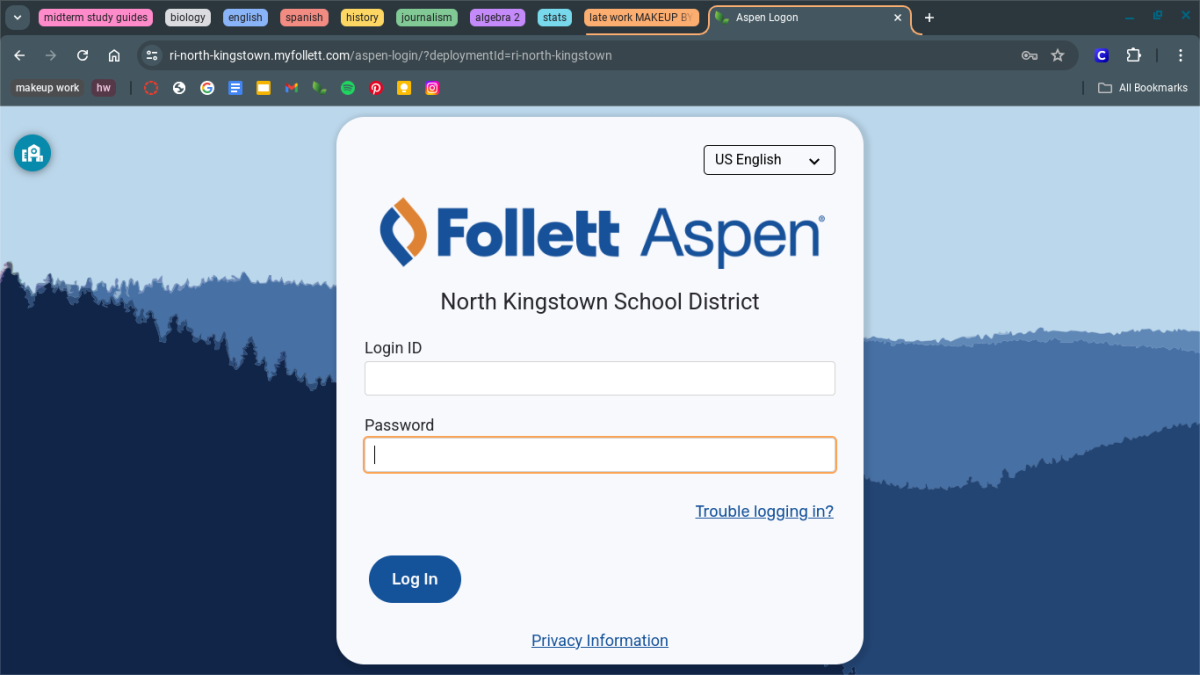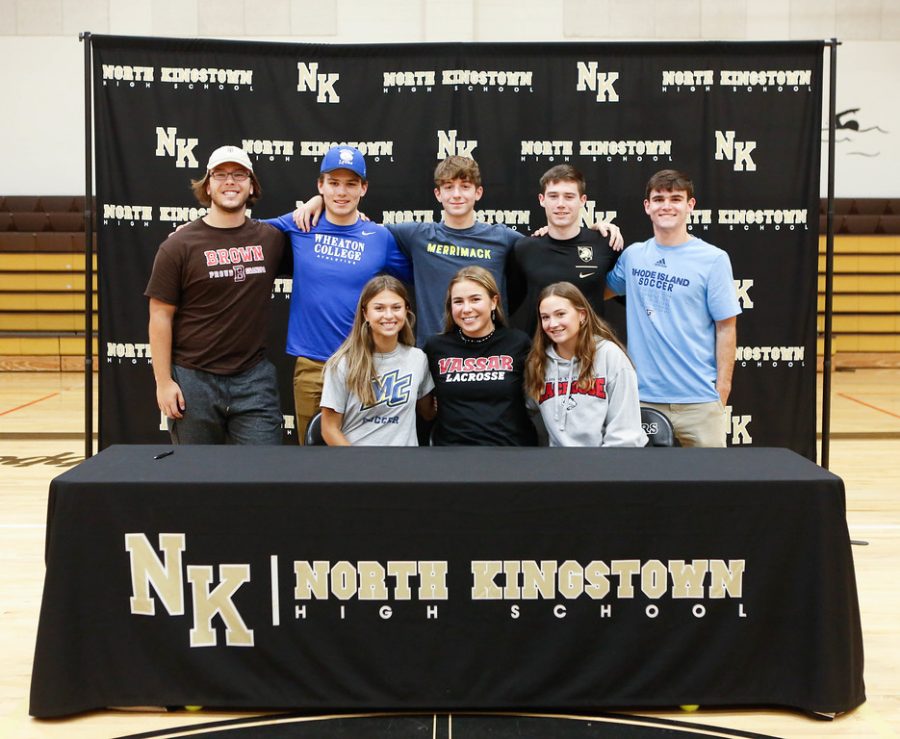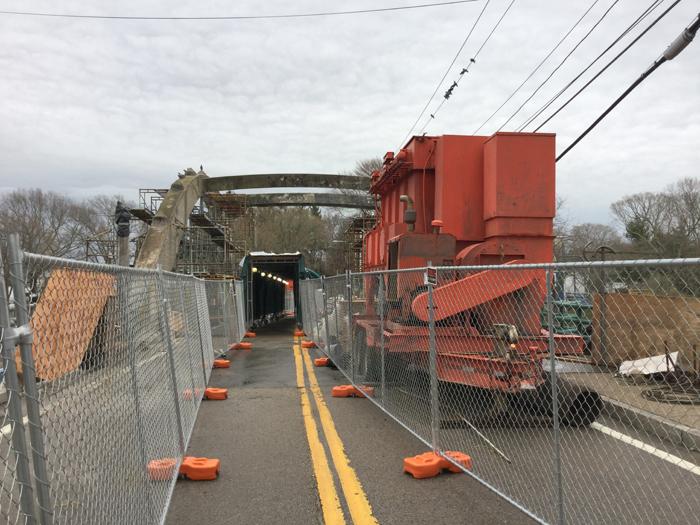Closure of Hussey Bridge forces administrators and students to adapt
The Hussey Bridge, which closed for renovations on April 1, will remain closed until June 24. After reopening during the summer months, it will shut down again for further construction between Sept.6 and Nov. 15. Throughout the closures, pedestrians will be able to use the pictured walkway to cross the bridge.
In response to the closure of the Hussey Bridge on April 1, which has split Boston Neck Rd. in two and has caused heavy congestion on numerous other streets, students and administrators have made numerous sacrifices and adjustments.
The Hussey Bridge renovation will be completed in two phases, which will affect NKHS students and staff for the remainder of the 2015-16 school year and the first two months of the 2016-17 school year. The first phase, which began on April 1, will span until June 24. After a respite from construction during the summer months, the bridge will close for renovations on Sept. 6 and will not reopen until Nov. 15.
Although the closure of the Hussey Bridge has proved to be inconvenient for nearly every NKHS student at one time or another, it has posed special problems for those students who live in the neighborhoods at the northern end of North Kingstown. Because they can no longer cross the Hussey Bridge on their daily journeys to and from school, these students must leave their houses earlier each morning or face the potential consequences of almost-inevitable traffic jams: tardy slips.
Like many other student drivers who reside in the northernmost region of North Kingstown, junior Katie Sullivan has started to leave her house earlier each morning in an effort to avoid the increased traffic. Sullivan, who lives in Mt. View, learned her lesson when she and her friend Kenzie Carlson, whom she regularly drives to school, arrived late at NKHS one morning after getting stuck in heavy traffic. Fortunately for Sullivan and Carlson, the administration held the bells that morning because they recognized that multiple other students were in the same situation.
Sullivan now leaves her house at 6:30 each morning, about 15 minutes earlier than she used to. “Leaving every day at 6:30 is tough because I normally wake up at 6:20,” she said. “Every morning, [Kenzie and I] either arrive at school really early, because we’ve missed the traffic entirely, or right before the bell rings, because we’ve gotten stuck in it.”
Although Dr. Mancieri, principal of NKHS, delayed the bells for the first week of school after the Hussey Bridge closed, which benefited Sullivan and Carlson in their moment of need, she will no longer continue to do so. “[S]tudents will [now] be expected to arrive on time,” Mancieri said. “We [had] a full week to understand the new traffic pattern and timing.”
Even so, Mancieri and her fellow administrators have taken numerous steps to mitigate the negative effects of the bridge closure. For example, they have worked alongside Mr. Daniel Silva, the school resource officer, to direct traffic before and after school each day. Mancieri also asked the North Kingstown Police Department (NKPD) if Silva could start his shift at 6:30 each morning in order to help reduce congestion at the corner of Annaquatucket Rd. and Fairway Dr., which the NKPD approved.
In addition, Mr. Brian McDonald, dean of students in grades 10 and 12, recommended that students from the southern and western neighborhoods of North Kingstown travel to school on Hamilton-Allenton Rd. instead of Annaquatucket Rd. He sent out an email to the student body on April 10 about this matter.
“Students should take alternate routes to school and get used to doing so,” McDonald said. “[The bridge closure] will continue to be an issue for the rest of this year and the beginning of next year.”
Evidently, the administrators’ efforts and suggestions served their intended purpose. According to Mrs. Donna Sweet, vice principal of student services, significantly fewer students arrived late to school during the second week after the closure of the Hussey Bridge than the first. “[Traffic-induced] tardiness is no longer a major problem,” Sweet said.
The Hussey Bridge first opened in 1925. It was named in honor of Clarence L. Hussey, Rhode Island’s first bridge engineer. Hussey, who designed the bridge, died before its completion. After Hussey designed the bridge in the through-arch style and ordered that it be constructed with concrete, the resulting structure became the first bridge of its kind in Rhode Island.
The current construction project on the Hussey Bridge marks the first time that it has undergone significant renovations since 1977. Before construction began on April 1, the Rhode Island Department of Transportation considered the bridge to be structurally unsound.
Senior Lydia Sgouros, who lives in a neighborhood south of the Hussey Bridge, has adapted more easily to the closure of the bridge than most students. Although she does not enjoy the loud noises that the construction on the bridge causes each day, Sgouros appreciates that Boston Neck Rd. has essentially become a dead-end street. Sgouros, who used to hear the sounds of countless motor vehicles as they approached the Hussey Bridge, now “enjoy[s] the quiet [nature] of the road at night.”
Sgouros also appreciates the increased police presence at the site of the bridge. For 12 hours each day, one police officer will be stationed at each end of Hussey Bridge until the first phase of construction ends on June 24.
Even though Sweet recognizes that most students and faculty, with the exception of a few individuals like Sgouros, are suffering as a result of the bridge closure, she hopes that everyone will maintain positive attitudes and continue to respect one another over the next few months.
“It is important for everyone to be patient and take turns during this process,” Sweet said. “We’re all in this together.”
Your donation will support the student journalists of North Kingstown High School. Your contribution will allow us to distribute a print edition of the Current Wave to all students, as well as enter journalism competitions.











